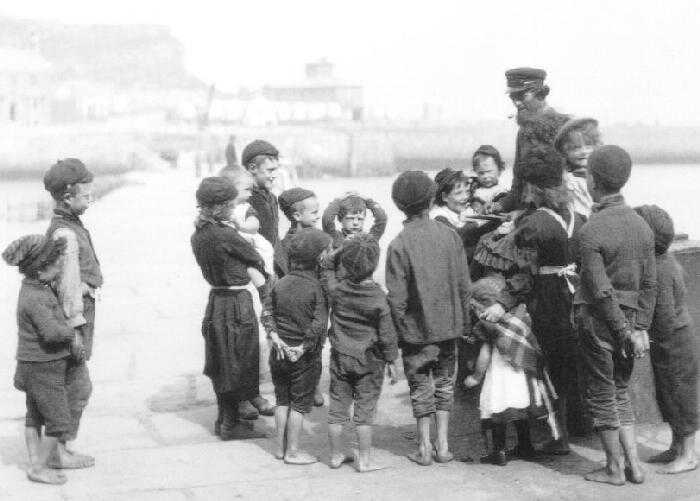
Figure 1.--This photograph was taken in Scarborough or other nearby seaside town about the turn of the 20th century. Note the number of boys wearing peaked school caps. We all see stocking caps and tams. |

|
English boys headwear has varied considerably over the years. Our archive of English images is still fairly small which limits our ability to assess the chronology of English headwear, especiaslly trends before the 20th century. Tri-corned hat seems the dominant style for both boys and men in the 18th century. By the 19th century we see both caps and hats.
We note a kind of peaked military cap in the early- and mid-19th century. American boys in the 19th century commonly wore rounded-crown hats. We are not sure how common they were in England. After mid-century we begin seeing the broad-brimmed sailor cap came into style. Sunsequent styles of sailor caps were also popular and followed changes in Royal Navy uniforms. The peaked school cap appeared as far as we can tell in the 1860s. It was commonly worn for the followeing ten decades. The flat cap was not as popular in England as it was in America, at least for boys. At the turn of the century, the peaked school cap was the dominant style for boys. We notice some boys wearing stocking caps. The peaked school casp was even adopted by the Cubs in 1916. Older boys might wear various styles of flat caps. The school cap began going out of style after World War II, especially in the 1950s. Headwear in general declined in popularity. Boys began wearing American baseball caps in the 1980s.
Our archive of English images is still fairly small which limits our ability to assess the chronology of English headwear, especially trends before the 20th century. Tri-corned hat seems the dominany style for both boys and men in the 18th century. Poor boys probably could afford these hats.
By the 19th century we see both caps and hats. We note a kind of peaked military cap in the early- and mid-19th century by better off boys. American boys in the 19th century commonly wore rounded-crown hats. We are not sure how common they were in England. After mid-century we begin seeing the broad-brimmed sailor cap came into style. Subsequent styles of sailor caps were also popular and followed changes in Royal Navy uniforms. The peaked school cap appeared as far as we can tell in the 1860s. It was commonly worn for the following ten decades and is still worn at a few private schools. It forst appeared at private schools. We are not sure that it became commonly worn by the wider population. The flat cap was not as popular in England as it was in America, at least for boys. Some boys did wear them, but it became even more common for working-class adults. We see some boys, mostly from affluent families, wearing berets and Tam O'Shanters, called tams. This was style worn by boys, at least younger boys, and girls. We also see boys wearing boaters in the late 19th century. Again this was more common as a school style. We also note boys wearing adult styled headwear as well as headwear styles that we can not yet identify.
Headwear was still widely worn by English boys in the early-20th century. At the turn-of-the 20th century, the peaked school cap was emerging the dominant headwear style for boys. We see some different styles such as flat caps. Yonger boys from affluent families might wear broad-brimmed hats. Older boys might wear boaters. Schools played a major role in setting styles. Boys at a few tony private schools wore top hats. We notice some boys seasonally wearing stocking caps. Boys of more modest circumstances might wear stocking caps, headwear that required more respectability as the century progressed. They were so common even adopted by the Cubs when the group was founded (1916). Most boys except for the particularly affluent had fairly simple wardrobes and if they had headwear it was commonly a peaked cap. Thus while they came to be called school caps, they were not just worn to school. The peaked school cap was ubiqutos after World War I (1920s). Interestingly while boys had virtually this one tyoe of headwear, girls had quite a range of different styles. The peaked cap becme a kind of iconic symbol of British boys. They were done in many different colors at private schools, but less so at state schools which did not have uniforms. Older boys might wear various styles of flat The school cap continued to be stabdard wear *(1939s). The school cap was still standard headwear at the time of World War II (1939-45). Large numbers iof boys reported for evacuation weaing their school caps. School caps began going out of style, but were still wide worn (1950s). Boys no longer liked wearing them. Some schools had strict rules, especially private schools. We see relatively few boys wearing school caps (1970s). aklthough Cubs continued wearing them. Headwear in general by this time wase declining in popularity. Boys began wearing American baseball caps (1980s). We even see col miners wearing them.
Headwear in the 21st centuryis no longer very common for English children, both boys and girls.
Navigate the Boys' Historical Clothing Web Site:
[Return to Main English headwear page]
[Return to Main war essay page]
[About Us]
[Introduction]
[Activities]
[Biographies]
[Chronology]
[Cloth and textiles]
[Garments]
[Countries]
[Topics]
[Bibliographies]
[Contributions]
[FAQs]
[Glossaries]
[Images]
[Links]
[Registration]
[Tools]
[Search]
[Boys' Clothing Home]
